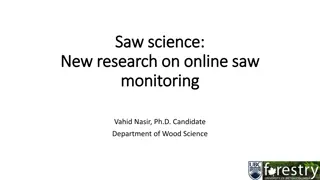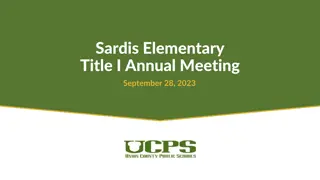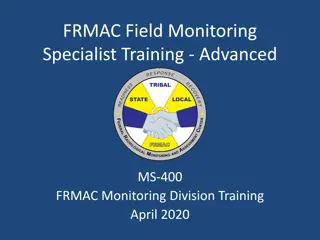Overview of Title I, Part D Monitoring in Education
This presentation covers the importance of monitoring Title I, Part D programs in education to ensure compliance with State and Federal laws. It includes information on the monitoring review processes, benefits of monitoring, and the different levels at which programs are monitored. The content also highlights the significance of federal monitoring and provides insights into monitoring tips for State Educational Agencies and local educational agencies.
Download Presentation

Please find below an Image/Link to download the presentation.
The content on the website is provided AS IS for your information and personal use only. It may not be sold, licensed, or shared on other websites without obtaining consent from the author. Download presentation by click this link. If you encounter any issues during the download, it is possible that the publisher has removed the file from their server.
E N D
Presentation Transcript
Overview of Title I, Part D Monitoring Victoria Rankin, Greta Colombi, NDTAC Chandra Martin, Arkansas Department of Education 1
Overview of Presentation Introduction to Monitoring Reviews What is monitoring review? Which programs are monitored? Why is monitoring beneficial? Monitoring Review Processes Federal, subgrantee Conducting Monitoring Reviews Onsite, offsite Challenges to Subgrantee Monitoring Reviews Monitoring Tips From an SEA Resources 2
What Is Monitoring Review? Program monitoring involves the regular and systematic examination of program implementation and administration Monitoring of Title I, Part D (Part D)-funded programs is conducted to ensure compliance with applicable State and Federal laws 3
Which Programs Are Monitored? Monitoring reviews occur at three levels: The U.S. Department of Education (ED) monitors State educational agencies (SEAs) that receive funds (Federal monitoring) SEAs monitor their State agency (SA) and local educational agency (LEA) subgrantees (subgrantee monitoring) SA and LEA subgrantees monitor the facilities and programs to which they allocate funds (facility monitoring) 4
Why Is Monitoring Beneficial? Allows administrators at all levels to ensure that students receive a fair, equal, and significant opportunity to obtain high-quality education/ programming Provides a mechanism for collecting information about State and local needs to enable administrators to target assistance and other resources more effectively 5
Federal Monitoring Eight of the leading indicators were approved: 1. The percentage of long-term students served (90+ calendar days) who have both pre- and posttest scores, Subpart 1 2. The percentage of long-term students served (90+ calendar days) who have both pre- and posttest scores in reading, Subpart 2 3. The percentage of long-term students served (90+ calendar days) who have both pre- and posttest scores in mathematics, Subpart 1 4. The percentage of long-term students served (90+ calendar days) who have both pre- and posttest scores in mathematics, Subpart 2 6
Federal Monitoring (Cont.) 5. The percentage of students who enrolled in a school after exit from a Title I, Part D program, Subpart 1 The percentage of students who enrolled in a school after exit from a Title I, Part D program, Subpart 2 The percentage of students served earning high school course credits up to 90 days after exit, Subpart 1 The percentage of students served earning high school course credits up to 90 days after exit, Subpart 2 6. 7. 8. 7
Federal Monitoring (Cont. 2) ED will calculate baseline measures using SY 12 13 performance data by August or September 2014. As part of this process, ED: Will ask about State and LEA performance on baseline measures in performance-oriented monitoring questions The baseline measures will then inform ED s technical assistance (TA) and monitoring of States May identify which States and LEAs seem to be underperforming on these indicators Will follow up with SEA staff to determine (1) if they are aware of underperformance and (2) specific measures to address it 8
Federal Monitoring (Cont. 3) There is increasing emphasis on having greater collaboration between ED staff and States Using data for strategies that will lead to continuous improvement of outcomes for students and programs under Part D More information about these processes and increased emphasis will be forthcoming in the next fiscal year 9
Subgrantee Monitoring Review Per the Federal statute and regulations, SEAs represented by State coordinators are required to: Monitor SA and LEA subgrantees implementation of Part D-funded programs Implement a monitoring process that involves conducting reviews on a set schedule and developing related monitoring protocols and tools In turn, SAs and LEAs are responsible for monitoring the facilities and programs to which they allocate funds 10
Conducting Subgrantee Monitoring Reviews Often done through: Offsite review Review documents (e.g., desktop review) Administer self-assessment Onsite review Review documents Interview SAs, LEAs (if SEA administers Subpart 2), and facilities Reviews at facilities (e.g., classroom observations) 11
Conducting Offsite Monitoring Two primary methods: Desktop monitoring SEA requests information/data, subgrantees submit, and SEA determines compliance Self-assessment Subgrantees complete and inform SEAs of compliance 12
Steps for Offsite Monitoring Process 1. Set offsite monitoring schedule 2. Determine what information/data to collect 3. Collect information/data 4. Review information/data 5. Respond to information/data 13
1. Set Offsite Monitoring Schedule In light of the onsite monitoring schedule, determine how often do you need to conduct offsite monitoring Consider the method(s) you plan on using and when 14
2. Determine What Information/Data To Collect Consider the requirements you wish to review Be sure to review if there is anything else you would like to know, for example: Do you have questions based on your review of their data and onsite monitoring results? Are there broader issues that you wish to investigate? 15
3. Collect Information/Data Tools you will use: Forms Checklists Vehicles you will use E-mail Online system Web-based survey Video/phone conference Other 16
4. Review Information/Data Check the information/data: Confirm receipt Confirm completeness Confirm quality Analyze the information/data: Identify isolated issues and/or problematic patterns Identify good examples that can be shared 17
5. Respond to Submitted Information/Data Response to identified findings: SEA writes official response/corrective action plan Subgrantee submits plan to address areas of noncompliance Response to findings and other identified issues: Develop a tiered TA approach based on analyses of results Tier 1: TA for all Tier 2: TA for some Tier 3: TA for a few 18
Subgrantee Monitoring Challenges Onsite monitoring reviews tend to be short and infrequent Staff turnover tends to be high Title I, Part D requirements can be challenging to understand Offsite monitoring is often necessary, but can be challenging without effective communication and tools that help to Coordinate the receipt of materials Coordinate among your team of reviewers Address issues as they arise 19
Subgrantee Monitoring: Your Responsibilities Create subgrantee monitoring protocols and guidelines Establish consistent monitoring cycles or schedules Require corrective actions for subgrantees not in compliance Ensure that LEAs and SAs are monitoring every facility with which they have contracted for services 20
Tips for Subgrantee Monitoring Released in 2013 Requested by State Title I, Part D (Part D) coordinators 2012 NDTAC Conference Goals of the tip sheet: Embed a youth- and staff-centered framework in the monitoring process Provide guidelines to capturing student and teacher perspectives Help Part D coordinators secure additional information during subgrantee monitoring 21
Types of Techniques To Gather Information and Examples of Questions: Interviews Technique Definition Examples of Questions Involve one-on-one questioning of individuals School/Program Administrators How do you monitor special education-related services, interventions, and support? Can be structured (all participants receive the same questions in the same order during each respective interview, with questions focused on a specific goal) or unstructured (questions are not presented in any specific order or format and, although the interviewer may have a specific goal or focus, participants are allowed to speak openly about any issue they wish to discuss) How do you ensure that all cumulative records are accurate and up-to-date? How do you monitor transition services, inclusive of Transition Coordinators, to ensure that transitions occur effectively? Do you have any suggestions for improving transition services? What are some ways in which positive behaviors are reinforced? Is there a schoolwide or facilitywide behavioral management system operating in the school or facility? If so, please describe. Interviews How do you ensure youth are enrolled in appropriate credit-bearing courses? How do you ensure quality education services are offered to all students? Can be conducted face-to-face (with staff and youth) or by telephone (with staff) 22
Types of Techniques To Gather Information and Examples of Questions: Questionnaires Technique Definition Examples of Questions Also referred to as surveys Students Do you feel your teachers are teaching you what you need to know? Do you feel teachers in your school try to help you? Was your class placement or schedule discussed with you on your first day of school? Do you receive a copy of your report card? Have you talked to someone about how you will transition to or return home and re-enroll in school? Do you expect to continue your education when you are released? Involve the random selection of approximately 20 30 percent of students and 50 percent of teachers Can be by either pen and paper or online Should have only small groups of students (15 or less) take it at once to minimize misbehavior or disruptions Teachers Are you certified by the State Educational Agency to teach in the area of instruction that is assigned to you? For this school year, how many hours or days have you participated in inservice or professional development training? Do you look forward to reporting to work? Would you say that, in this school, teachers are encouraged and have the opportunity to support and challenge students to achieve? Do you encourage your students to aspire to go to college, vocational training, or some other form of higher education? Do you use interventions to help students with their behaviors? Are career and technical education (vocational education) portfolios developed for all of your students? Should be read by a facilitator to students to ensure that they are understood Question- naires 23
Types of Techniques To Gather Information and Examples of Questions: Focus Groups Technique Definition Examples of Questions Require participation of at least 5 10 individuals randomly selected to participate in a group discussion Students Do you feel your school is preparing you for life, a job, and further education? How would you improve discipline in your school? What incentives are there to encourage positive behaviors? What would you do to make the school better? Do you know the principal of the school? Is there an adult in the school or facility that you can go to if you have a problem? (The intent is to determine if there is an adult in the school or facility that the student trusts) Student focus groups should include most academic placement groups (e.g., high school, GED, special education, career/technical/ vocational education) Teacher focus groups should represent most instructional groups (e.g., high school, GED, special education, career/technical/ vocational education) Teachers What are you doing to prepare each of your students for statewide testing? What are you doing to enhance and supplement classroom instruction? How do you motivate your students? What suggestions do you have for improving the instructional process? How are transitional needs being addressed for regular as well as special populations? Do you have any suggestions for how to improve transition services? How are inservice training needs being met? What has been most beneficial? Focus Groups 24
Monitoring TIPs From an SEA Chandra Martin Program Advisor, Arkansas Department of Education State Title I, Part D Coordinator 25
Resources Guide to Meeting Compliance Requirements for the Title I, Part D, Program, available on the NDTAC website ND Communities Monitoring and Compliance topic page for examples of subgrantee monitoring forms and protocols from many States Federal Monitoring Forms available under Monitoring Indicators on the ED Web site http://www2.ed.gov/admins/lead/account/monitoring/ index.html NDTAC s Tips for Subgrantee Monitoring http://www.neglected- delinquent.org/sites/default/files/Monitor_Tipsheet_ 2013_508%20FINAL.pdf Your NDTAC State Liaison! 27























